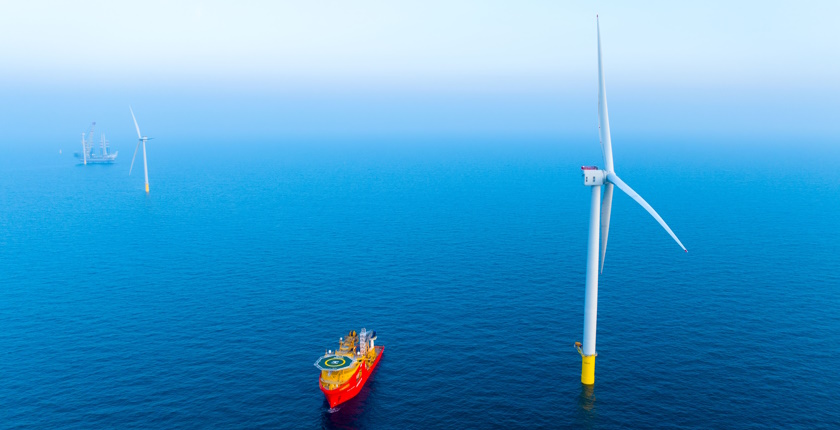
Photo: Dogger Bank Wind Farm
Dogger Bank, the world’s largest offshore wind farm under construction, has started producing electricity for the first time and supplying it to Britain’s national grid. The Dogger Bank project has delivered several world-firsts in supply chain delivery.
The 3.6 GW Dogger Bank Wind Farm is being built in UK waters 130 km off the coast of Yorkshire and in the UK’s North Sea in three 1.2 GW phases known as Dogger Bank A, B, and C. Full commercial operation is planned for 2026.
The first turbine at Dogger Bank A has started turning and producing electricity, said Norway-based energy company Equinor, one of the wind farm’s developers.
When complete, Dogger Bank will be the world’s largest offshore wind farm, more than two and a half times the size of the largest offshore wind farm currently operating – the 1.4 GW Hornsea 2, located 9 km off the Yorkshire coast.
Dogger Bank is being developed and built by Equinor, SSE Renewables, and Vårgrønn (a joint venture of Eni Plenitude and HitecVision).
According to SSE, the company is a lead operator for the development and construction phase. At the same time, Equinor will be the lead operator of the wind farm for its expected operational life. Vårgrønn secures specialist offshore wind expertise for the project.
The first use of Hitachi Energy’s HVDC Light® transmission system
Power from the offshore wind farm is now being transmitted to the UK’s national grid via Dogger Bank’s high-voltage direct current (HVDC) transmission system, marking the first use of HVDC technology on a UK wind farm.
This includes the installation of the world’s first unmanned offshore HVDC substation platform at the site, as well as the first use of Hitachi Energy’s HVDC Light® transmission system, which was executed in a record time of 38 months with the highest safety and quality standards, Equinor said.
Each rotation of the 107m long blades can produce enough energy to power an average British home for two days.
When fully complete, its 3.6 GW capacity will comprise 277 offshore turbines capable of producing enough energy to power the equivalent of six million British homes annually.
World-firsts in supply chain delivery
The Dogger Bank project has delivered several world-firsts in supply chain delivery that will significantly accelerate the speed at which future offshore projects can be developed, Equinor said.
Its first power followed the installation of the first of GE Vernova’s Haliade-X 13 MW turbines, one of the largest and most powerful globally, at the Dogger Bank site. This is the first time Haliade-X units have been energized offshore anywhere in the world.
GE Vernova’s new 13MW Haliade-X turbine technology was completed by technicians and engineers working off Jan De Nul Group’s newest jack-up installation vessel, Voltaire.
With a lifting capacity of 3,200 tonnes, the Voltaire is the largest offshore jack-up installation vessel of her kind in the world and the first ultra-low emissions ship of its kind, Equinor stressed.
Opedal: Dogger Bank constitutes an industrial wind hub in the heart of the North Sea
Anders Opedal, CEO of Equinor, said that Dogger Bank demonstrates the best of what the offshore wind industry can offer, with innovative technologies, long-term jobs, and economic growth and security of electricity supply at a major scale.
“A renewable mega-project like Dogger Bank constitutes an industrial wind hub in the heart of the North Sea, playing a major role in the UK’s ambitions for offshore wind and supporting its net zero ambitions,” Opedal added.
According to Alistair Phillips-Davies, CEO of SSE, the project is a landmark moment for the global offshore wind industry. Dogger Bank demonstrates what can be achieved when policymakers, investors, industry, and communities work together to achieve something truly remarkable.
“Dogger Bank’s first power milestone demonstrates that offshore wind is ready to power Europe’s energy transition,” said Olav Hetland, CEO of Vårgrønn.
Facchin: The urgent energy transition requires global standards
GE Vernova Offshore Wind CEO Jan Kjaersgaard said that the company is committed to electrifying the world while simultaneously working to decarbonize it.
According to Claudio Facchin, CEO of Hitachi Energy, the urgent energy transition requires strong collaboration, new business models, and global standards.
“We are proud to be the technology partner for the Dogger Bank Wind Farm project, with HVDC being the force multiplier for the clean energy transition, increasing access to an energy system that is more sustainable, flexible, and secure,” Facchin stressed.
Jan Van Impe, Manager of Jan De Nul Offshore Renewables at Jan De Nul Group, said that Voltaire has proven today that the scale and characteristics of the offshore Dogger Bank turbines offer the perfect challenge for this next-generation state-of-the art jack-up installation vessel.


















Be the first one to comment on this article.